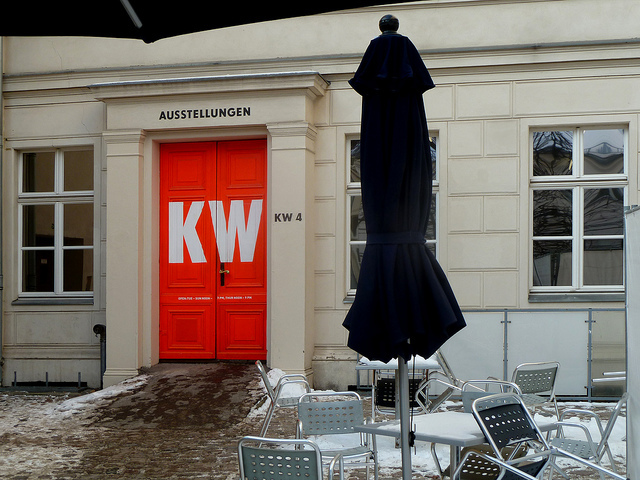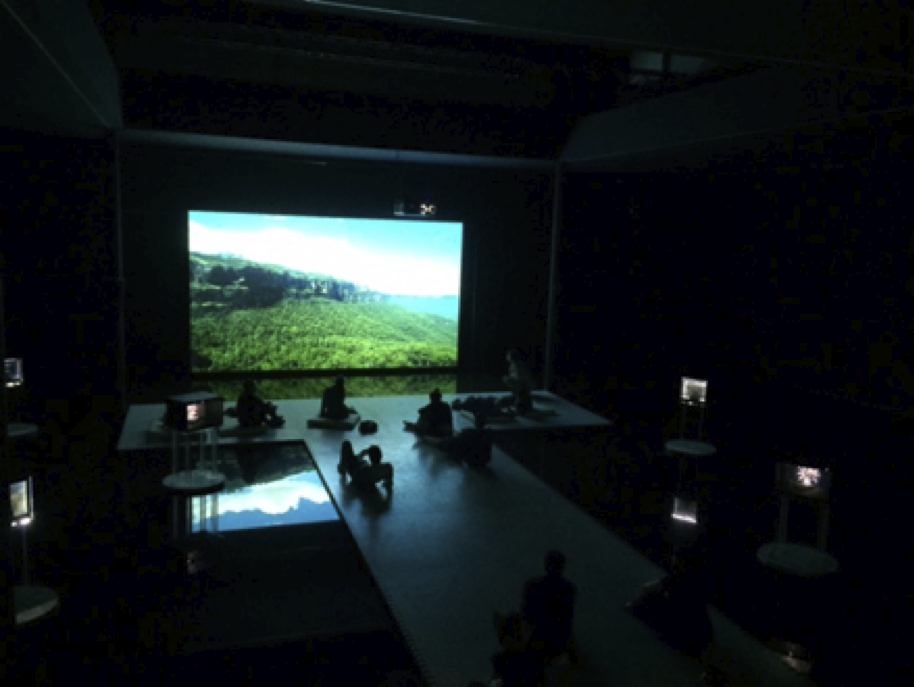
On the mezzanine of the Akademie der Künste, the main venue for this year’s Berlin Biennale, two girls watch a man in a tutu shimmy across an LED screen. He pauses to take a selfie. Things get sensual.
“I don’t get it,” says one girl to the next.
That seems to be exactly the reaction that this year’s curators, the NYC-based collective known as DIS, hope to elicit. In interviews and press releases, DIS has expressed the desire to create an exhibition as paradoxical, nonsensical, and uninterpretable as the world we’re living in. This is an age, the show reminds us, when clicks act like votes and corporations are as powerful as states, as digital capitalism continues its steady colonization of public, private, and political life.
But why settle for a critique when you can dress the contemporary up in drag?
If art masquerading as commercial enterprise counts as “drag,” then DIS—best known for its online fashion mag and e-shop—has lived up to its chosen epigraph for the 9th Berlin Biennale (BB9): “The Present in Drag.” BB9 arrives in the garb of corporate despotism; most of the art on view is selling something slick. The lobby of the Akademie der Künste could easily be mistaken for a joint product launch between Telfar white tees, MINT green juice, and hardshell luggage—trending consumer products that double as installations by Telfar Clemens, Débora Delmer, and Anna Uddenberg, respectively, and whose prominent placement announces that this exhibition makes no distinction between commerce, politics, and art. Nor between gallery and reality. Recognizable brands and corporations (BitCoin, Google, Miu Miu, the German soda manufacturer Club-Mate) receive direct shout-outs, while this year’s blue, geometric insignia, splashed across BB9’s investor-ready promotional materials, appears to be a mischievous riff on the Deutsche Bank logo. (Not so coincidentally, the German bank is also the world’s largest corporate art collector.) This is a Biennale with a sense of humor. Masquerades are for fun.


The faux-commercial premises of these installations are in line with the curators’ e-commerce spirit and Photoshopped aesthetic, less so with the Biennale’s tradition of social critique. BB9 takes reality as a prompt, a point of departure and source of potential, rather than an object of analysis. It reimagines the world as we know it. Still, social commentary hovers behind the corporate gloss. To DIS’s credit, the interactive works they’ve commissioned (a performance based on user-generated data; blank tablet screens that ask you to imagine the products and ads they don’t actually display) invite the viewer to participate in the conceptual construction of a well-curated thought experiment: Imagine the world as single corporation.
This is the thesis of UK-based Christopher Kulendran Thomas’s New Eelam (2016), a mixed-media installation that warns against the pitfalls of nationalism and private ownership while pushing a new program of corporate collectivism. Posing as a start-up, New Eelam’s promotional video recycles the neo-Marxist ideologies of the Tamil Tigers and historical footage of war-torn Sri Lanka to pitch citizenship by subscription—think Citi Bike pass meets passport, except in a post-national utopia where you borrow everything you’d normally own. Viewers watch the ad from a swanky “experience suite,” a model of the fully furnished apartments subscribers can rent like bicycles while jet-setting across a borderless globe. In a world without nations, everyone is a tourist. And what could humans possibly go to war over then?
The call for fluid, corporate citizenship is echoed in Simon Denny and Linda Kantchev’s Blockchain Visionaries (2016), an installation that takes its name from the code used to support supranational digital currencies like BitCoin. In collaboration with Denny, Kantchev has transposed the logos of actual digital currency start-ups onto postage stamps—in a post-national world, having your face on a postage stamp, an honor once reserved for national heroes, is instead bestowed on corporations. Denny’s video installation delivers utopian aphorisms (“Imagine a world where trust was a given,” “Imagine a world without borders”) that carry into the next room, where static mannequins spread the word from TED Talk-esque stages. The price for this post-national pamphleteering is aesthetic variety; both the Eelam and Blockchain installations seem to have lifted their ethereal narrators and prepackaged visuals from the same one stop shop for global domination.
GCC, a collective of artists based in Dubai, takes on self-optimization culture in their installation Positive Pathways (+) (2016). A heavily synth-ed female voice expounds the powers of “positive energy,” a metaphysical flow that anyone can tap, like an oil well, in order to “become a success.” The voice can be attributed to a statuette of a head-scarfed mother standing in the sandy infield of a springy, four-lane running track, delivering this life lesson to her son. The choice to show Positive Energy and Blockchain in the European School of Management and Technology—former home to the “Staatsrat,” the city council of Communist East Berlin—suggests that these new utopian experiments have little more to offer than the fascism of the old.

The show is spread across five different venues throughout the city center—the Akademie der Künste, the business school ESMT, the KW Contemporary Institute for Art, a former bunker, and a sightseeing pontoon. The audio production—foregrounded in Positive Pathways (+)—is a highpoint in each. BB9’s aquatic, ethereal sound is the work of LA sound artist Ashland Mines, whose multi-tonal, synthesized harmonies establish aural coherence across the Biennale’s disparate venues. The continuity of the audio heightens the sense that the entire Biennale was created by a single corporation (i.e., DIS), an effect is that becomes especially prominent in the open space of the Akademie der Künste, where audio from multiple video installations blends together into a sort of meta-soundtrack. Unsurprisingly, that soundtrack, called “Anthem,” is also for sale; miniature vinyls are available in limited supply. It’s exciting to see sound play a central role in BB9 but regrettable that visual production tends to take a backseat. The schematic installations risk fading into a corporate washout; one wishes that this year’s high-budget, highly produced, and euphonious Biennale had more to offer the eye.
Magnified across five different venues, DIS’s sense of humor—and relentless corporate poker face—can be exhausting. Over at the KW Institute for Contemporary Art, however, one finds a hint of the human. Amalia Ulman’s Privilege (2016), like Positive Pathways (+), takes its cue from self-optimization culture, this time refracted through the contradictory images of motherhood, career, and beauty perpetuated by mass media—and the fact it is only from the privileged position of artist that one finds the Archimedean point to critique and ironize those contradictions. The artist, dressed in her office best, looks quizzically into mirrors and reflective elevator doors as she smacks her pregnant belly. The video cuts to the name brand punchlines: Gucci, Miu Miu. Here women’s liberation arrives as motherhood in stilettoes, high fashion’s newest silhouette. Down the hall, Alexandra Pirici’s Signals (2016) filters user-generated search data back through the human body, as performers reenact popular search engine hits, including Beyoncé’s “Drunk in Love,” the “Confused Travolta meme,” and Bill Clinton’s public apology. Unfortunately, this conceptually brilliant blend of dance, performance art, and light show falls short of what it could be—elements of the choreography and costuming (the dancers, clad in black Spandex, wear glow-in-the-dark beads that flash like “signals” as they move through the dark) could be dial-up. As is, the performance seems suspended in post-production limbo, a fully fledged concept only half-realized on the stage.
Cécile B. Evans’s video installation What the Heart Wants (2016), also at KW Institute, is a Biennale standout both for its humanity and for its stunning layering of the natural world with animated characters and imagery. Rather than a cold, ideological utopia, this narrative film presents a dystopia from what is at least a semi-human perspective; our narrator, a faceless digi-ton, longs to become human. The film’s constellation of vignettes follows a cadre of other protagonists who once lived in the 20th century but have since been “deleted” from digital records of that era. Those that we meet (off-grid drifters, a HeLa cell, an anime heroine, a colony of disembodied ears that inhabits a post-apocalyptic Lagos) exist in a digital limbo—wherever memories go when we delete them. For all the BB9’s agenda for paradox and cold corporate gloss, Evans manages to lend one of the most paradoxical and visually innovative moments of the whole Biennale a human touch. In the film’s final frames, the faceless, animated narrator performs a strange, slow-motion pop dance, a melancholic piece of choreography that comes off as a poignant declaration of selfhood—a denouement to an increasingly corporate world that would brand us all the same.

The intertwining themes of utopianism and self-optimization create an algorithm: improve yourself = improve the global brand! DIS may have meant this as tongue-in-cheek, a final pun. But the equation takes on a new valence against the backdrop of Berlin’s recent past—this the central tautology of fascism, after all, which equates individual destiny with the destiny of the state. One wonders: For all DIS’s posturing about knocking contemporary art off its soapbox, does their ironic flare culminate in a searing statement—the contemporary = corporate fascism—about the way we’re living? Or are these curators simply playing gauche with ideological absolutisms? DIS, brand-new to the curating scene, does have a tendency to put taboo before taste, and a particularly flamboyant slogan from one of the Biennale’s ads–“Why should fascists have all the fun?”–earned them a slap on the wrist from some critics. But this sort of cheekiness comes off as more juvenile than sinister. On the whole, DIS’s amoral imagination has viewers asking questions—and imagining consequences.
DIS’s foray into making art “fun” enough to compete with fascism is enough to make one cringe and, paradoxically, sigh with relief. Here’s an exhibition that dares not to moralize, an abstinence that puts pressure on old questions about politics and art. But it may also be worth remembering that while ideologies are neat, easily translated into glossy videos and posters, human beings are messy—an inconvenient truth for absolutist schemes, including aesthetic ones. For all the Biennale’s post-national, corporate gallivanting, the lasting impression I carried from the exhibit heralds from the fiercely personal. Written by Mohammad Abu Hajar, commissioned by BB9, and produced in collaboration with Red Bull Studios, the lyrics to the music video Homeland (2016) echo in a way that aphoristic shock does not. Hajar’s narrative rap follows the flight of refugees from Syria to Berlin Tempelhof Airport, currently used as temporary shelter and where integration lessons are mandatory: How to stop at street lights. How to piss. How to find a job (“Everybody tells you ‘No Syrian'”). Integration comes as a final assault to human dignity that Hajar’s last lines reject:
I have a homeland, I have a homeland, I have a homeland
I will return even if the timing is prolonged.

